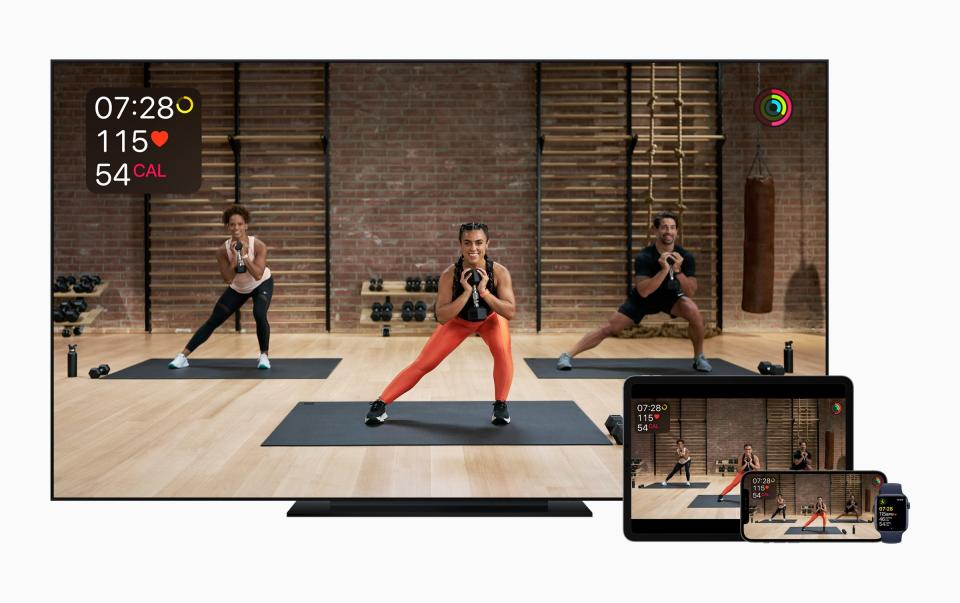Apple’s Fitness+ Is the Latest Shot in Silicon Valley’s At-Home Workout Wars—Will it Dethrone Peloton?
Virtually every gym rat I know has overhauled their routine this year to become some kind of at-home digital fitness connoisseur. (I surely don’t have to tell you why.) This shift to at-home workouts is reshaping the entire fitness industry. This year Peloton’s stock reached astronomical heights, peaking at more than quadruple the price on New Year’s Day. Peloton’s paid user base has more than doubled over the last year. Soul Cycle launched an at-home bike. Cycling simulator Zwift closed a $450 million funding round. Lululemon bought the company behind the $1,500 Mirror fitness device and now projects $150 million in revenue in 2021. Investors and corporations are betting that the pandemic will permanently change the way we work out even after we’re all vaccinated—and now so is Apple, as Fitness+, the tech giant’s new streaming fitness platform, launches today.
While it’s a bit reductive to call Fitness+ Cupertino’s answer to Peloton, the formula is familiar by now: The app charges $10 a month to access a library of workouts choreographed to booming music, with competitive leaderboards and a roster of charismatic and inspiring instructors to also stalk on Instagram. GQ got a few days of early access to kick the tires and try to figure out if yet another at-home workout service is worth shelling out for every month.
As I fired up the service on my iPad for the first time, I couldn’t help but feel like the absolute perfect person to pass judgement. After nine months of pandemic life, I’ve tried what feels like every streaming workout and app there is, and I’ve gotten picky. But as you would expect from the company, Fitness+ is an incredibly slick app, where users can choose workouts from nine different categories: HIIT, yoga, core, strength, treadmill, cycling, rowing, dance, and “mindful cooldown.” The studio used for filming is gorgeous, and the quality of the videos is top notch. I’ve tried my fair share of subpar fitness content this year (Terrible lighting! Dogs running rampant!), and the attention to detail really makes a difference.

Subscribers are meant to use their own equipment, including whatever treadmill or spinning bike they have, or (someday) can use at their gym—as far as we know, there’s no matte white Apple Bike in development. The app is tightly integrated with a different piece of hardware, though: the Apple Watch. Whether you’re using the app at the gym on an iPhone or in your living room with an Apple TV, you’ll get cues and vibrations on your wrist that synch up with the workout, and the watch will beam biometric stats like heart rate and calories burned to the screen. In fact, you need a watch to make this thing work—the company is serious about making the watch an integral part of the workouts. One morning, as I went to go scroll through the service to see what class I should take on later that day, I hit an “unavailable” screen just because my watch was turned off on the charger. (Apple says subscribers will get a workaround for this in case they—for example—head off on a business trip and forget their watch behind.)
The watch also drives the competitive aspect of Fitness+. The service offers a “burn bar” so that users can see how their individual effort stacks up to other users around the world. As someone who already shares workout activity with friends using my wearable, I like that a friend and I can take the same class and compare notes. (Show I can totally outwork them, I mean.) This aspect will certainly feel familiar to Peloton fans.
The surest sign that Apple is taking direct aim at Peloton’s business, though, is the lineup of 21 trainers you can take on-demand classes with. It’s a compelling and diverse bunch, many whom you might recognize from Instagram or other fitness platforms. Anyone who’s spent time with a Peloton knows that service is not really about the bike, or hitting your numbers—what keeps you coming back about developing a relationship with your favorite trainers. Apple clearly hopes they can replicate that parasocial magic. It’s obviously early, but they have some work to do before that happens. There will presumably be room for each trainer to develop their own personalities and show a little more vulnerability as the platform matures, but right now it’s a little upbeat motivation—it can feel a little robotic.

Their classes span from 5 to 45 minutes, and users can also filter by music style—from hip-hop and EDM to “chill vibes,” if Norah Jones is what you need to get your heart rate up. A neat Apple Music integration allows you to save any tunes you particularly like, and a lot of thought has clearly gone into pairing both big efforts with heavy beat drops and mellow moments with more soothing tunes.
Beyond music, the cueing across the classes is just excellent. You can expect smart, well-timed recommendations for exactly how to move your body—bracing your core to safely execute a movement or relaxing your shoulders in chair pose. These guys know their shit. They have obviously also taken pains to make things extremely accessible. Whether you’re tackling a 30-minute run or a 10-minute yoga session, there’s always one person off to the side scaling the workout, modifying the moves for different skill levels. If you’ve ever cursed as you try in vain to copy the way lithe YouTube yoga instructors pretzel themselves, this is for you. The service is also clearly tuned to make movement a habit—consistently closing rings, as the app visualizes it—rather than smashing some single macho effort.
On the flip side, right now the service doesn’t exactly cater to a more experienced athlete. My guess is that this will evolve with time, but currently the classes are relatively basic and beginner-friendly. Notably, while cycling instructors offer up a suggested range of pedal strokes per minute, treadmill instructors avoid providing any certain pace range, rather focusing on perceived effort. That’s a perfectly good way to train, but it might feel limiting if you’re the kind of runner who knows how fast you ran your last half marathon.
Another thing: Unlike Peloton and other competitors, there are no live classes—something that’s a big draw for many who want to feel like part of a bigger community. There’s something about showing up to a 10 a.m. live treadmill bootcamp class and then getting direct messages from friends saying “I saw you on the leaderboard today!” along with virtual high fives—to say nothing of the potential for the ever-coveted live instructor shout-out. As of now, Fitness+ will be dropping new on-demand content in each category every Monday.
These are minor gripes relative to the quality of the workouts—Apple Fitness+ is immediately near the top of a very crowded field on day one. The quality of the production and the workouts themselves is off-the-charts good, and the service is also ideal for anyone who actually wants great music paired with high quality workouts—this combination has proven harder to find than you might guess.
The product is good enough that if you’ve already got the Watch, I’d say checking it out is a no-brainer—especially since, until the end of March, current watch owners get a free month. (New watches come with three months free.) For people that don’t already have an Apple Watch, it gets a bit trickier. Picking one up is certainly cheaper than shelling out four figures for a Peloton (you can get a Series 3 for like $150 these days), and the data from the watch means it’s much more personalized than purely steaming offerings. But it might be too high of a bar for anyone who is already content with straightforward videos for their home workout. Which raises a bigger question: Nine months into the pandemic, is Fitness+ just late to the streaming fitness party? (Of course, Apple Music similarly felt a little late when it launched in 2015; it’s now the number-two music streaming service.)
The bigger question for me is whether the streaming fitness boom is sustainable—whether anyone will still want to stream their workouts when we don’t have to. If Fitness+ fails to take off, I’ll be surprised, but there will also be a natural explanation: It launched the very same day Americans started getting vaccinated for COVID, and we couldn’t wait to get back to gathering for fitness classes in person.
Fitness
Whether you want to work on strength, flexibility, or cardio, there's an app that will help you get a workout from home.
Originally Appeared on GQ


